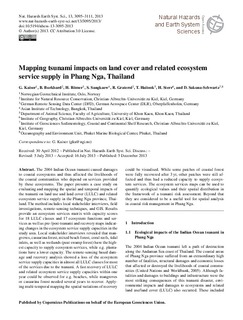Mapping tsunami impacts on land cover and related ecosystem service supply in Phang Nga, Thailand
Kaiser, Gunilla; Burkhard, B; Römer, H.; Sangkaew, R; Graterol, R; Haitook, T; Sterr, H.; Sakuna-Schwartz, D
Journal article
Permanent lenke
http://hdl.handle.net/11250/2375315Utgivelsesdato
2013Metadata
Vis full innførselSamlinger
- NGI articles [1037]
Originalversjon
Natural hazards and earth system sciences 2013, 13(12):3095-3111 10.5194/nhess-13-3095-2013Sammendrag
The 2004 Indian Ocean tsunami caused damages to coastal ecosystems and thus affected the livelihoods of the coastal communities who depend on services provided by these ecosystems. The paper presents a case study on evaluating and mapping the spatial and temporal impacts of the tsunami on land use and land cover (LULC) and related ecosystem service supply in the Phang Nga province, Thailand. The method includes local stakeholder interviews, field investigations, remote-sensing techniques, and GIS. Results provide an ecosystem services matrix with capacity scores for 18 LULC classes and 17 ecosystem functions and services as well as pre-/post-tsunami and recovery maps indicating changes in the ecosystem service supply capacities in the study area. Local stakeholder interviews revealed that mangroves, casuarina forest, mixed beach forest, coral reefs, tidal inlets, as well as wetlands (peat swamp forest) have the highest capacity to supply ecosystem services, while e.g. plantations have a lower capacity. The remote-sensing based damage and recovery analysis showed a loss of the ecosystem service supply capacities in almost all LULC classes for most of the services due to the tsunami. A fast recovery of LULC and related ecosystem service supply capacities within one year could be observed for e.g. beaches, while mangroves or casuarina forest needed several years to recover. Applying multi-temporal mapping the spatial variations of recovery could be visualised. While some patches of coastal forest were fully recovered after 3 yr, other patches were still affected and thus had a reduced capacity to supply ecosystem services. The ecosystem services maps can be used to quantify ecological values and their spatial distribution in the framework of a tsunami risk assessment. Beyond that they are considered to be a useful tool for spatial analysis in coastal risk management in Phang Nga.
Beskrivelse
-
